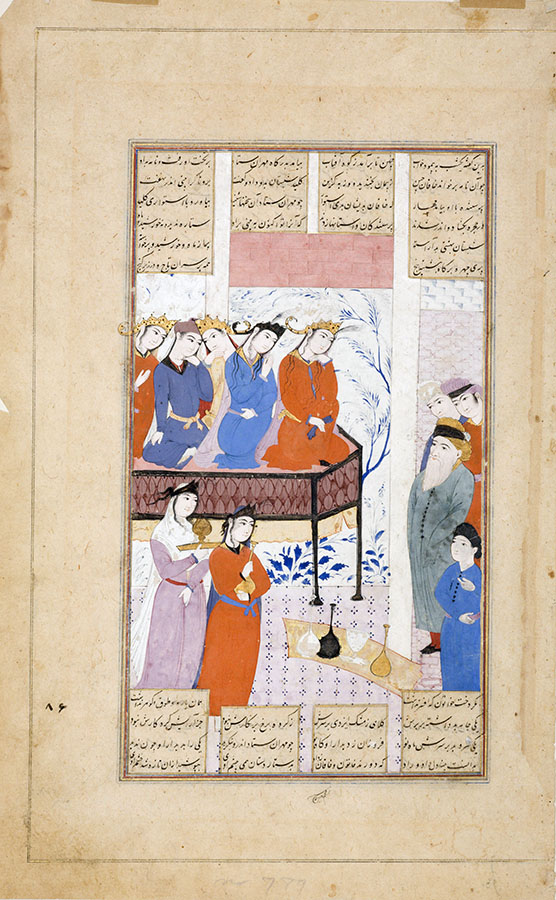Moʿin Moṣavver | Manuscripts | Shahnama of Ferdowsi
Manuscript E, no. 7-351
Anuširavān Sends Mehrān Setād to the Ḵāqān to Choose a Wife for Him
Location: Nasser D. Khalili Collection of Islamic Art, London, ms.1031r
Page: 36.3 x 22.5 cm
Painting: 26.0 x 15.0 cm
Text area: 26.0 x 15.0 cm.
Text: four column; deepest column 10 lines on a 30 line per full page matrix.
Illustration number: The number 86 written in Arabic numerals, presumably of later date, appears in the lower left margin, probably indicating that it was the eighty-sixth painting in the manuscript.
Mehrān Setād and his party -- an elderly man with a long beard and turban, accompanied by three younger companions -- are on the extreme right of the painting. Five daughters of the Ḵāqān of Chin are seated on an elevated throne in the upper left. Four princesses are daughters of concubines, and one is the daughter of the queen -- but Mehrān Setād, chosen for this task because of his wisdom, is able to determine which is the true princess. Two standing servants with flasks in hand, and several additional flasks set on the ground before the throne, complete the foreground..
The text columns consist of four or six lines above the painting and three or four lines below, on a 30 line per page format. The painting and text are completely contained within the confines of the ruled frame. The painting is signed by Moʿin, in the lower margin: raqam-e kamina moʿin-e moṣavver. It is not dated. At the very bottom of the page is the number 789 written in Western numerals, next to a single illegible word in Persian script, probably denoting some previous collection or lot number. The same number is also written on the verso.
Painting references:
Anderson Gallery, 20-21 December 1929, Lot 330 (not illustrated).
Sothebys London, 11 October 1991, Lot 849 (ill.)
Sothebys London, 15 October 1998, Lot 64 (ill.)
Brend, Epic_2010, p.203, #84 (ill.)
Text references:
Warner, VII, pp. 349-54; Mohl, VI, p.273.
Provenence: Formerly in the Collection of Hassan Khan Monif in New York in 1929, where it appears in an Anderson Gallery sale of artifacts in his collection. It was not sold at that sale. Reappears again at two subsequent sales at Sothebys in 1991 and 1998.
Photo: ©Nour Foundation. Courtesy of the Khalili Family Trust
Robert Eng
Last Updated: January 31, 2013 | Originally published: May 21, 2003
Manuscript E, no. 7-351
Anuširavān Sends Mehrān Setād to the Ḵāqān to Choose a Wife for Him
Location: Nasser D. Khalili Collection of Islamic Art, London, ms.1031r
Page: 36.3 x 22.5 cm
Painting: 26.0 x 15.0 cm
Text area: 26.0 x 15.0 cm.
Text: four column; deepest column 10 lines on a 30 line per full page matrix.
Illustration number: The number 86 written in Arabic numerals, presumably of later date, appears in the lower left margin, probably indicating that it was the eighty-sixth painting in the manuscript.
Mehrān Setād and his party -- an elderly man with a long beard and turban, accompanied by three younger companions -- are on the extreme right of the painting. Five daughters of the Ḵāqān of Chin are seated on an elevated throne in the upper left. Four princesses are daughters of concubines, and one is the daughter of the queen -- but Mehrān Setād, chosen for this task because of his wisdom, is able to determine which is the true princess. Two standing servants with flasks in hand, and several additional flasks set on the ground before the throne, complete the foreground..
The text columns consist of four or six lines above the painting and three or four lines below, on a 30 line per page format. The painting and text are completely contained within the confines of the ruled frame. The painting is signed by Moʿin, in the lower margin: raqam-e kamina moʿin-e moṣavver. It is not dated. At the very bottom of the page is the number 789 written in Western numerals, next to a single illegible word in Persian script, probably denoting some previous collection or lot number. The same number is also written on the verso.
Painting references:
Anderson Gallery, 20-21 December 1929, Lot 330 (not illustrated).
Sothebys London, 11 October 1991, Lot 849 (ill.)
Sothebys London, 15 October 1998, Lot 64 (ill.)
Brend, Epic_2010, p.203, #84 (ill.)
Text references:
Warner, VII, pp. 349-54; Mohl, VI, p.273.
Provenence: Formerly in the Collection of Hassan Khan Monif in New York in 1929, where it appears in an Anderson Gallery sale of artifacts in his collection. It was not sold at that sale. Reappears again at two subsequent sales at Sothebys in 1991 and 1998.
Photo: ©Nour Foundation. Courtesy of the Khalili Family Trust
Robert Eng
Last Updated: January 31, 2013 | Originally published: May 21, 2003
